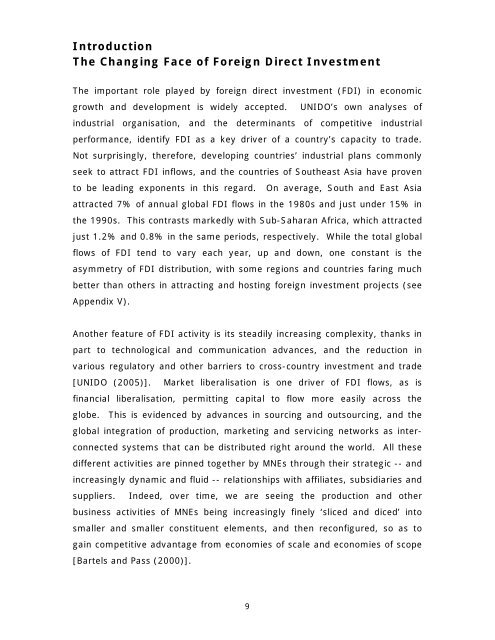(EGM) Foreign Direct Investment in Southeast Asia - Unido
(EGM) Foreign Direct Investment in Southeast Asia - Unido
(EGM) Foreign Direct Investment in Southeast Asia - Unido
Create successful ePaper yourself
Turn your PDF publications into a flip-book with our unique Google optimized e-Paper software.
Introduction<br />
The Chang<strong>in</strong>g Face of <strong>Foreign</strong> <strong>Direct</strong> <strong>Investment</strong><br />
The important role played by foreign direct <strong>in</strong>vestment (FDI) <strong>in</strong> economic<br />
growth and development is widely accepted. UNIDO’s own analyses of<br />
<strong>in</strong>dustrial organisation, and the determ<strong>in</strong>ants of competitive <strong>in</strong>dustrial<br />
performance, identify FDI as a key driver of a country’s capacity to trade.<br />
Not surpris<strong>in</strong>gly, therefore, develop<strong>in</strong>g countries’ <strong>in</strong>dustrial plans commonly<br />
seek to attract FDI <strong>in</strong>flows, and the countries of <strong>Southeast</strong> <strong>Asia</strong> have proven<br />
to be lead<strong>in</strong>g exponents <strong>in</strong> this regard. On average, South and East <strong>Asia</strong><br />
attracted 7% of annual global FDI flows <strong>in</strong> the 1980s and just under 15% <strong>in</strong><br />
the 1990s. This contrasts markedly with Sub-Saharan Africa, which attracted<br />
just 1.2% and 0.8% <strong>in</strong> the same periods, respectively. While the total global<br />
flows of FDI tend to vary each year, up and down, one constant is the<br />
asymmetry of FDI distribution, with some regions and countries far<strong>in</strong>g much<br />
better than others <strong>in</strong> attract<strong>in</strong>g and host<strong>in</strong>g foreign <strong>in</strong>vestment projects (see<br />
Appendix V).<br />
Another feature of FDI activity is its steadily <strong>in</strong>creas<strong>in</strong>g complexity, thanks <strong>in</strong><br />
part to technological and communication advances, and the reduction <strong>in</strong><br />
various regulatory and other barriers to cross-country <strong>in</strong>vestment and trade<br />
[UNIDO (2005)]. Market liberalisation is one driver of FDI flows, as is<br />
f<strong>in</strong>ancial liberalisation, permitt<strong>in</strong>g capital to flow more easily across the<br />
globe. This is evidenced by advances <strong>in</strong> sourc<strong>in</strong>g and outsourc<strong>in</strong>g, and the<br />
global <strong>in</strong>tegration of production, market<strong>in</strong>g and servic<strong>in</strong>g networks as <strong>in</strong>ter-<br />
connected systems that can be distributed right around the world. All these<br />
different activities are p<strong>in</strong>ned together by MNEs through their strategic -- and<br />
<strong>in</strong>creas<strong>in</strong>gly dynamic and fluid -- relationships with affiliates, subsidiaries and<br />
suppliers. Indeed, over time, we are see<strong>in</strong>g the production and other<br />
bus<strong>in</strong>ess activities of MNEs be<strong>in</strong>g <strong>in</strong>creas<strong>in</strong>gly f<strong>in</strong>ely ‘sliced and diced’ <strong>in</strong>to<br />
smaller and smaller constituent elements, and then reconfigured, so as to<br />
ga<strong>in</strong> competitive advantage from economies of scale and economies of scope<br />
[Bartels and Pass (2000)].<br />
9

















